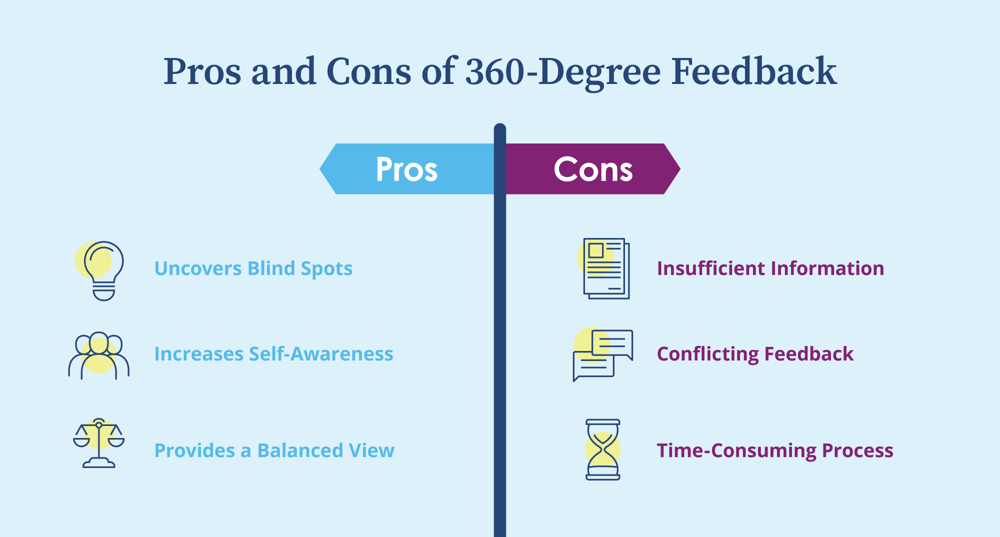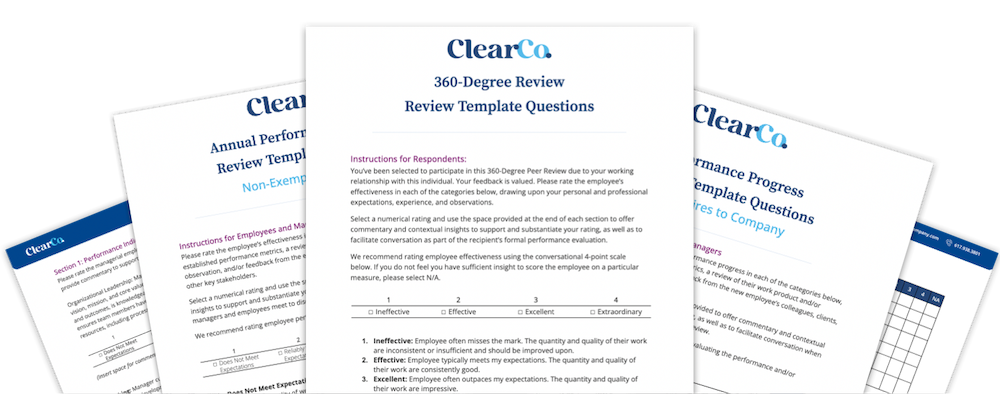This article on 360 reviews best practices was first published in January 2021 and updated with new information in March 2024.
Did you know that only 13% of employees and managers say employee reviews are useful? According to performance management statistics, 77% of human resources leaders say they’re not even an accurate representation of how employees are doing. Luckily, times have changed, and there are many new and effective ways to evaluate your employees in addition to traditional annual reviews. One method of performance reviews that has been gaining popularity is 360-degree feedback.
Employees today don’t just want to hear everything they’re doing wrong or get a generic “great job” from their managers. They want opportunities to grow, detailed, constructive feedback, and recognition for their strengths. 360-degree reviews are an excellent tool for companies that want to offer these options and do more than just evaluate performance.
So, what exactly is 360-degree feedback, and how can your organization benefit from using this performance management tool?
What Is 360-Degree Feedback?
360-degree reviews involve gathering feedback from multiple sources — supervisors, teammates, and direct reports —about an employee’s performance. Sometimes, contributors even include clients or partners employees work with closely. Evaluations and feedback are consolidated into a holistic view of performance and can be used to make actionable changes.
The 360 review process operates based on anonymity. Employees are provided the comfort of knowing that their feedback is not tied to their name so they feel safe speaking honestly. Supervisors often distill the responses into a report or summary to discuss with their employees, focusing on the main points to anonymize the feedback further. Then, the supervisor and employee can work together to develop an action plan based on the review.

When it comes to 360-degree feedback, one size does not fit all. You need to tailor your approach to your workforce and create targeted questions that help you gather useful data. Be sure to ask both closed- and open-ended questions to collect a combination of quantitative and qualitative data.
After you’ve chosen the questions to ask in peer reviews, you can kick off your process. Here are the five basic steps for executing 360 reviews:
- Select Reviewers: Decide which team members, peers from other departments, leaders, and external contributors will participate in the employee’s 360-degree review. If they’re a manager, be sure to involve direct reports, too.
- Gather Feedback: Use an employee survey platform or performance management software to send reviews and collect responses. Be sure to designate whether or not responses are anonymous.
- Compile Response Reports: Create a report summarizing the responses that can be shared with the employee to guide discussion and provide insight. If reviews are anonymous, be sure to share responses without compromising reviewers’ anonymity.
- Meet to Discuss Feedback: Managers and employees must meet to discuss the feedback they receive. Thanks to the report compiled in step three, common strengths and weaknesses in the employee’s job performance should be clear.
- Create an Action Plan: Design a personalized development plan to address any areas for improvement and hone the employee’s strengths.
Armed with the right knowledge and support tools, any organization can take charge of its review process and implement a peer-review system.
Should You Be Using 360 Degree Feedback?
Understanding the benefits and drawbacks can help you decide whether a 360-degree feedback program could work for your team. Below, we break down the pros and cons to consider before introducing 360-degree feedback.

Pros of 360 Feedback
1. Uncovers blind spots.
One of the top reasons for 360-degree feedback is that it brings in more than just the manager’s perspective on employee performance. Depending on their relationship with the employee being evaluated, each reviewer adds more insight — from every level of the organization. With the added visibility, opportunities for continual improvement and professional development become more apparent.
2. Increases self-awareness.
360-degree feedback aims to portray a complete and holistic view of your performance. By gathering feedback from several parties, employees can get a more accurate view of their strengths and weaknesses. It becomes easier to see where they need to improve or recognize what they’re best at when several voices echo each other.
For added benefit, have employees spend time comparing their self-assessment to the assessments they receive from their coworkers. This helps them understand how their work and attitude are perceived by their coworkers and can determine where changes are needed.
3. Provides a balanced view.
Many people have issues with traditional performance reviews because they feel they are ineffective. The traditional review opens the door to bias and provides a narrow view of overall performance, especially for remote organizations. 360-degree feedback creates a complete view of employee performance, leading to more accurate and fair reviews.
Cons of 360 Feedback
1. Insufficient information.
The best way to get honest, helpful information is by gathering anonymous feedback. Employees feel more comfortable speaking candidly when they know that their names will not be attached to the comments. However, this can lead to a lack of sufficient information regarding performance or attitude issues.
Without a plan for gathering more information regarding specific events, employees may find that the feedback they receive doesn't provide enough background to make actionable changes. Turn this con around by creating a process for managers to follow up with reviewers about incomplete answers before meeting with the employee.
2. Conflicting feedback.
Without proper structure, 360-degree feedback can provide conflicting information. Organizations need to ensure they are clear with expectations and how the review procedure works to establish trust with their employees. The potential for conflict occurs with the added subjectivity of peer reviews. However, with a consistent and robust system in place, you can ensure that the data you receive is accurate and fair.
3. Time-consuming.
Collecting and reviewing feedback, as well as entering data into your systems, can be very time-consuming. However, HR leaders can significantly reduce the time it takes to conduct 360-degree reviews by leveraging performance management software. With a software system, your team can:
- Quickly build and send 360 reviews accessible on any device
- Effortlessly gather and aggregate anonymous responses
- Keep reviews on track with automatic reminders and notifications
- Give unprecedented insight into employee performance
The best review systems also integrate well with your other software systems and offer real-time data access.
360 Reviews Best Practices
You’ve weighed the benefits and drawbacks of using a 360-degree performance model and have decided that the process works well for your organization. But what’s next?
Understanding best practices for a strong, fair performance review system will alleviate stress and create a verifiable and repeatable process. Here are four best practices to keep in mind when creating your 360-degree feedback system.
1. Set goals for 360-degree reviews.
As with any new strategy, defining your goals is key. Goal-setting helps you keep your priorities at the forefront and ensure you don’t lose sight of what you want to achieve with the reviews. You can have several different goals for 360 reviews, but the important part is defining them.
Do you want to provide more thorough, actionable reviews? Maybe your organization is also looking to better understand skill gaps in your workforce. Whatever you want to accomplish, put goals down in writing so you can find the right strategy and tools to support them.
2. Establish trust and credibility.
Your 360-degree feedback will only be useful if your employees trust your system and the feedback they receive. You must create a culture of trust when completing the reviews. Communicate transparently with your team about the desired outcome of these reviews — not to critique their performance but to find ways to better support their growth and development.
Ensure your employees understand that the feedback they provide to their coworkers is anonymous so that you can receive honest responses. By showcasing your review process’s effectiveness and accuracy, employees will be more willing to embrace feedback.
3. Consistency is key.
With any review process, 360-degree feedback is most effective when done consistently and frequently. Establishing a consistent approach for gathering and reviewing feedback will also increase the accuracy of the data you receive. Best practices for 360-degree feedback include surveying performance at least every several months.
Another added benefit of consistent reviews is that they enable managers to compare performance across time. You’ll be able to see the efficacy of your new review strategy in real time and build historical data that supports it.
4. Provide quality feedback and training.
Provide guidance and training to both employees and reviewers on how to give and receive constructive feedback effectively. Encourage raters to provide specific examples and actionable suggestions for improvement rather than vague comments. You should also emphasize the importance of focusing on behaviors and outcomes rather than personal traits or characteristics. It’s also critical to be sure employees have the support and resources to interpret and apply the feedback they receive.
5. Follow up and take action.
Arguably one of the most essential parts of any review is the follow-up. When organizations fail to follow up with employees, they miss out on opportunities for strategic action. After creating the action plan, hold meetings regularly to check in on progress, increasing accountability for both managers and employees. The follow-up meeting offers insight into the effectiveness of these changes and opens discussions on whether the development plan is worthwhile or if it needs revisions.
360-Degree Review Software
360-degree feedback provides a comprehensive view of employee performance —and your HR team needs a tool for comprehensive 360-review management.
ClearCompany Performance Management software can help you seamlessly implement a 360-degree review strategy. You can rest assured that the data you gather through our anonymous surveys and performance-tracking software is timely and accurate.
ClearCompany has all the functionality you need to kick off 360 reviews:
- User-friendly and easy to complete on any device
- Automatic review communications and reminders to keep everyone on track
- Customizable formats and questions
- Automatically aggregate and anonymize responses
For more information on our Performance Management platform, sign up for your free demo today.




.webp)
